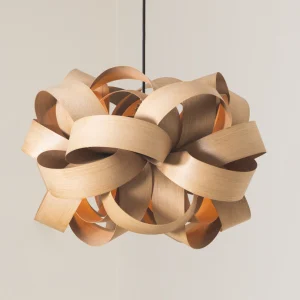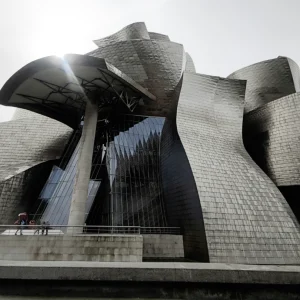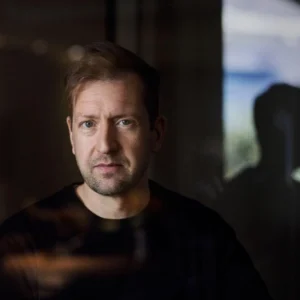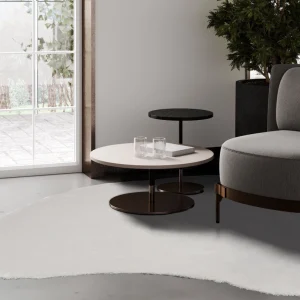WHAT IS THE PURPOSE of the Beaufort Triennale? A public art festival that is now in its eighth iteration, the objectives of the region’s cultural and tourism organisations that fund it include attracting more tourists from surrounding countries to this windswept, dune-fringed coast. On the first night of the official 2024 press tour, attended by French, German, Spanish and Italian journalists in high numbers, a smaller cohort of British press warned the hopeful Belgian representatives at our table that we have enough rainswept beaches of our own, thanks. But that was before we had set foot on the sand the next day, which, thankfully, brought some glorious spring sunshine to win us over – we were also more than a little beguiled by the fact that there is a 67km-long tramline that goes all the way along the coast. It’s been running for 100 years, with 68 stops and it only costs €3 for a day ticket, with unlimited interruptions. There’s an incentive for starters, never mind the ease (and sustainability) with which you can travel there by Eurostar.
 The Herring by Johan Creten; located near the Zeebrugge docks, Ivan Morison’s Star of the Sea is made of repurposed concrete sewage pipes; US architecture practice SO-IL’s Common Thread, ‘an undulating octopus’ of silvery knitted tunnels. Image Credit: Veronica Simpson
The Herring by Johan Creten; located near the Zeebrugge docks, Ivan Morison’s Star of the Sea is made of repurposed concrete sewage pipes; US architecture practice SO-IL’s Common Thread, ‘an undulating octopus’ of silvery knitted tunnels. Image Credit: Veronica Simpson
This stretch of coast is hugely popular with Belgians, but mainly for seasonal breaks. The mayor of De Panne, the town where we started, informed us that there are 11,000 people living in this municipality, though around 8,000 of them are second-homeowners, occupying the many quirky houses or holiday apartments, boosted by 40,000- 60,000 additional summer visitors. Its main asset, the mayor told us, is proximity to the French border and its natural charms – around 800 hectares of dunes and beaches.
So how can 18 new sculptures (and a slew of remnants from previous festivals) add to those charms? We started our tour with Filip Vervaet’s public fountain and pavilion outside a brick church, which is about to be turned into a library. Lit up at night by glowing, bluegreen, bauble-like beacons, the matching glass and steel pavilion can be admired from afar or entered, to reveal that the fountain’s level rises and falls in tune with the sea, a few blocks away. Set in new landscaping, this permanent work marks out a new civic space for when the church/library opens later this year. So far so good. But the next permanent work, by Johan Creten, is the kind that gives public art a bad name. Here, a huge naked woman, her face and breasts pointing out to sea, dangles a large fish from navel to crotch. It’s a herring apparently, referencing the role that this fish has played in the region’s survival – though why it would be worn as a thong, as it is here, is far from clear.
 The Herring by Johan Creten; located near the Zeebrugge docks, Ivan Morison’s Star of the Sea is made of repurposed concrete sewage pipes; US architecture practice SO-IL’s Common Thread, ‘an undulating octopus’ of silvery knitted tunnels. Image Credit: Veronica Simpson
The Herring by Johan Creten; located near the Zeebrugge docks, Ivan Morison’s Star of the Sea is made of repurposed concrete sewage pipes; US architecture practice SO-IL’s Common Thread, ‘an undulating octopus’ of silvery knitted tunnels. Image Credit: Veronica Simpson
By and large, the work is mostly thoughtful, pleasurable or useful – sometimes all three. One of the latter, which spoke of deep immersion with local people and issues, was Selva Aparicio’s bronze, high-backed bench, placed in a newly reclaimed marshy site along a stretch of Nieuwpoort’s waterways, once a World War One frontline. Called At Rest, the back is a jigsaw of over 4,000 bronze tiles featuring casts of the lined palms of local elders with whom Aparicio worked closely. The warm bronze and tactile quality of these individual palm prints bears witness to loss and age and yet also resilience, with its view over the calm, reed-fringed water.
After that moment of quiet, Ivan Morison’s delightful Star of the Sea structure, made of repurposed concrete sewage pipes (they are rejects from a nearby pipe factory, the artist assures us, and not previously contaminated) brought a blast of fresh ozone. Half buried in the sand near the Zeebrugge docks, you can crawl inside them for a spooky/mysterious experience, and many children were already doing so, as well as running and jumping over their sand strewn surfaces. Set, deliberately, a good walk across the beach at a point that might get your feet wet but won’t submerge you, it looks from afar like a collapsed sandcastle.
This work is a co-commission with the simultaneously programmed Triennale Brugges (or, as we know it, Bruges), a less established festival that has the complex but rewarding task of animating the exquisite medieval streets and aged brick structures of this thriving tourist city, with its multitude of museums and former monasteries. The idea is to draw people away from the tourist hotspots and into the quieter corners. In this, curators Shendy Gardin and Stevie Tsampalia have done an excellent job.
 The Herring by Johan Creten; located near the Zeebrugge docks, Ivan Morison’s Star of the Sea is made of repurposed concrete sewage pipes; US architecture practice SO-IL’s Common Thread, ‘an undulating octopus’ of silvery knitted tunnels. Image Credit: Veronica Simpson
The Herring by Johan Creten; located near the Zeebrugge docks, Ivan Morison’s Star of the Sea is made of repurposed concrete sewage pipes; US architecture practice SO-IL’s Common Thread, ‘an undulating octopus’ of silvery knitted tunnels. Image Credit: Veronica Simpson
There are 12 works placed around the city. The first we encounter is by the Swedish architect duo Novell/Rodhe who have created a new community garden, an outdoor living room, from salvaged pieces of marble, timber and stone, sourced from a nearby reclamation yard. We learned, however, that it was already being used by locals as a garden, but perhaps more will be drawn to it now. In which case, it accords with the Triennial theme Spaces of Possibility, as does Mexican artist Mariana Castillo Debali’s Firesong For The Bees. A sturdy timber frame, adorned with clay pots made by Debali, to echo ancient bee-related vessels (for smoking out hives, gathering honey), supported three active hives, provided (and tended to) by local beekeepers. It aims to highlight the perilous depletion of our bee populations while drawing visitors into the small but charming Sebrechtspark.
Adding further fascination to an overlooked garden was US architecture practice SO-IL’s Common Thread, an undulating octopus of silvery knitted tunnels (created with Dr Mariana Popescu of TU Delft and Summum Engineering) that invite exploration, while celebrating a sleepy garden behind a former Capuchin monastery. Meanwhile, Palestinian-British artist Mona Hatoum added a darker note with a swing placed within a grey-brick lined structure embedded in a grassy mound in the public garden of Bruges’ psychiatric hospital – speaking of constraint, but also offering, as she said, ‘the possibility of freedom’.
Both festivals are impressive in scope and scale. As Morison noted, one of the most inspiring aspects of working on his commission was doing so for a cultural sector that seems well run, funded and appreciated, unlike in his UK homeland.
I wish both Triennials well. And I suspect that it’s not just us northern European neighbours this region will appeal to: a windswept and rainy coast may soon become vastly preferable to a scorched, southern European one.





